

Ficus microcarpa is a small, easy bonsai often found in DIY and home furniture stores.
Facts about Ficus microcarpa
Name – Ficus microcarpa
Family – Moraceae (mulberry family)
Type – indoor plant
Height – 16 to 40 inches (0.4 to 1m)
Soil – indoor plant mix, well drained
Exposure: indirect but luminous – Foliage: evergreen – Watering: moderate
It is great for growing indoors and doesn’t require complicated follow-up. This home-friendly bonsai will do great in any room of the house as long as it gets light and proper moisture.
Your Ficus microcarpa bonsai will do great indoors.
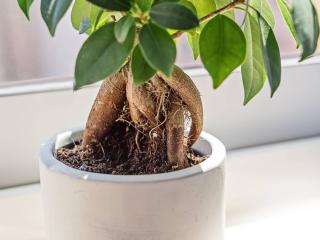 Year-round temperatures hovering around 60 to 70 or 75°F (15 to 25°C) are perfect.
Year-round temperatures hovering around 60 to 70 or 75°F (15 to 25°C) are perfect.Repotting your Ficus microcarpa is essential, every 1 to 3 years.
 Once a year is perfect, and you can pair it with trimming, defoliating and pruning to slowly create a majestic, elegant bonsai.
Once a year is perfect, and you can pair it with trimming, defoliating and pruning to slowly create a majestic, elegant bonsai.Fresh soil ensures nutrients are replenished. It’s also a way to monitor root growth and check that the potting mix isn’t rotting wet. Cut roots growing through drainage holes so that water flows freely.
This is a plant that naturally thrives in moist, humid climates.
 Soil must stay moist without being wet or soggy.
Soil must stay moist without being wet or soggy.Growth and vegetation slows, so your Ficus microcarpa needs less water.
Bring your Ficus microcarpa to the sink and gently spray soft water on its leaves from time to time. That’s the perfect treat!
Ficus microcarpa can grow huge in the wild in tropical climates, but in your house you want it to remain a smallish bonsai for best effect.
Ficus microcarpa sprouts new sprigs directly from the bark of the trunk. Thanks to this, you can’t make any “long-lasting mistakes” when pruning!
There are two ways of keeping your Ficus microcarpa under control. Choose whichever suits you best!
1. Constant pruning means checking on the plant often and removing twigs and growth that doesn’t please you.
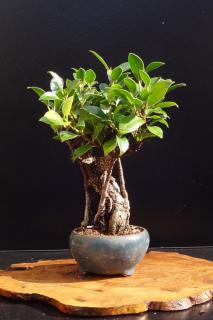
Every time you count up to ten new leaves, cut sprigs back, removing four to six new leaves in the process.
2. Seasonal pruning means only checking on the plant once or twice a year. Pruning is heavier.
There are slight differences in pruning that depend on whether your microcarpa bonsai is grafted or not:
Also, you might see air-roots forming – keep these, they look nice! This is common in moist and warm environments.
The dozens of Ficus microcarpa varieties differ in leaf size, leaf shape, leaf thickness, bark color… Nature is very inventive and breeders have noted many appealing variations. Note that they’ll all grow gigantic if left unpruned…
 A few popular bonsai Ficus microcarpa varieties stand out:
A few popular bonsai Ficus microcarpa varieties stand out:
In ideal moisture conditions, all species send out aerial roots, like a banyan tree. This species also goes by the name “Chinese banyan tree” to prove the point!
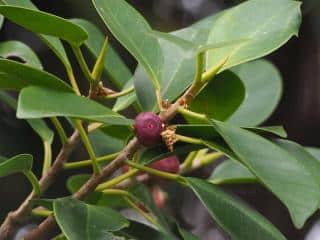 “Ficus” means “fig”. So Ficus microcarpa is basically a fig tree! However, “microcarpa”, translates into “tiny fruit”. It thus bears tiny fig-like fruits.
“Ficus” means “fig”. So Ficus microcarpa is basically a fig tree! However, “microcarpa”, translates into “tiny fruit”. It thus bears tiny fig-like fruits.
They only appear when conditions are just right. When they do, they’re very cute! Ficus microcarpa fruits are half an inch across (1 cm), and start out green before maturing to red and black.
They aren’t edible for us but birds love them.
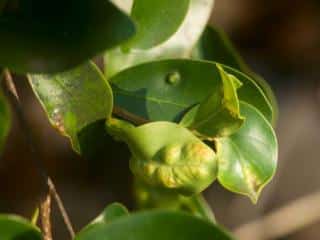 Pests that attack Ficus microcarpa are common houseplant pests: scale insect, thrips and spider mite essentially.
Pests that attack Ficus microcarpa are common houseplant pests: scale insect, thrips and spider mite essentially.
As for diseases, here is a quick troubleshooting guide to see what might be hurting your bonsai:
Ficus microcarpa is native to Southern China and the islands of Oceania, but its success as an easy houseplant means it now spans the world.
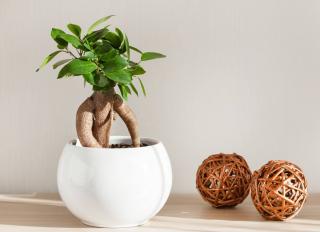 A relative of the common fig tree, this Ficus is particularly well suited to bonsai. Beginners appreciate it because it grows fast, is easy to train, and is very forgiving if you forget to water it or care for it at times. It won’t die on you on a whim like other, more fragile bonsai ficus!
A relative of the common fig tree, this Ficus is particularly well suited to bonsai. Beginners appreciate it because it grows fast, is easy to train, and is very forgiving if you forget to water it or care for it at times. It won’t die on you on a whim like other, more fragile bonsai ficus!
There’s a trick to telling it apart from the Ficus tree (F. benjamina). Look at the tips of leaves: sharp, pointed leaves belong to Ficus benjamina, whereas slightly rounded tips are Ficus microcarpa.
At times, a sister species called Ficus retusa is mistaken for microcarpa. Retusa has thinner, curvy trunks. Stores often sell one for the other, under the name Ficus ginseng!
Like all other ficus, this species can fuse its trunks together. If you want to grow a thick bonsai fast, wrap thinner stems together and within three or four years they will have grown into a single wide trunk!
very interesting i just buy tree ficus and start whit seed 4choice but just 2 star to grow is a royal poinciara and rocky mountain pine and this article is just at time for me, i love plant but don’t have a lots of light in my appt. but i buy some bulb special for plant and all of them are beautiful and now i just look to no how to work for my new one.
Hello Richard, that’s great that you found this helpful! Ficus microcarpa is indeed a very easy ficus to grow and care for. It also doesn’t need very much light, so even without a bulb it would still do fine, it would just grow slower. I’m sure it will thrive with the care you give it!
I’ve just bought my ficus microcarpa and I am unsure what kind of vitamins to incorporate in the water when feeding and spray the leave’s.
Hi Fiona, first off a reminder: it’s always best to use rainwater if you can collect it. This helps avoid build-up from minerals present in tap water (calcium especially). It also reduces white marks left behind on leaves when spraying or misting the ficus.
Secondly, Ficus microcarpa mostly needs nitrogen (N), and a little of the usual phosphorus (P) and potassium (K). So either go with a fertilizer that has three same numbers for N-P-K, for instance 12-12-12, or one that has a higher first number like 6-4-4. That’s for fertilizers you’d buy in stores.
The best ever fertilizer, however, is one made from plants at home. With this recipe for home-made fertilizer, you can convert anything like grass trimmings to vegetable peels into fertilizer. It’s a smelly process, so keep it outdoors. Since this comes from plants themselves, the resulting juice or “tea” contains all the nutrients a houseplant needs, already broken down by bacteria and made available for roots to soak up. Only use a little bit, though, just follow the dilution recommendations in the recipe.
Thank you so much for this educational article on the ficus microcarpa!
Thank you for such an in-depth article on these cuties! I just bought one at a club store, I only knew it was a Ficus! Lol I feel a bit more confident in caring for it!
They’re very forgiving, so you needn’t worry. Happy you liked the article! All the best!